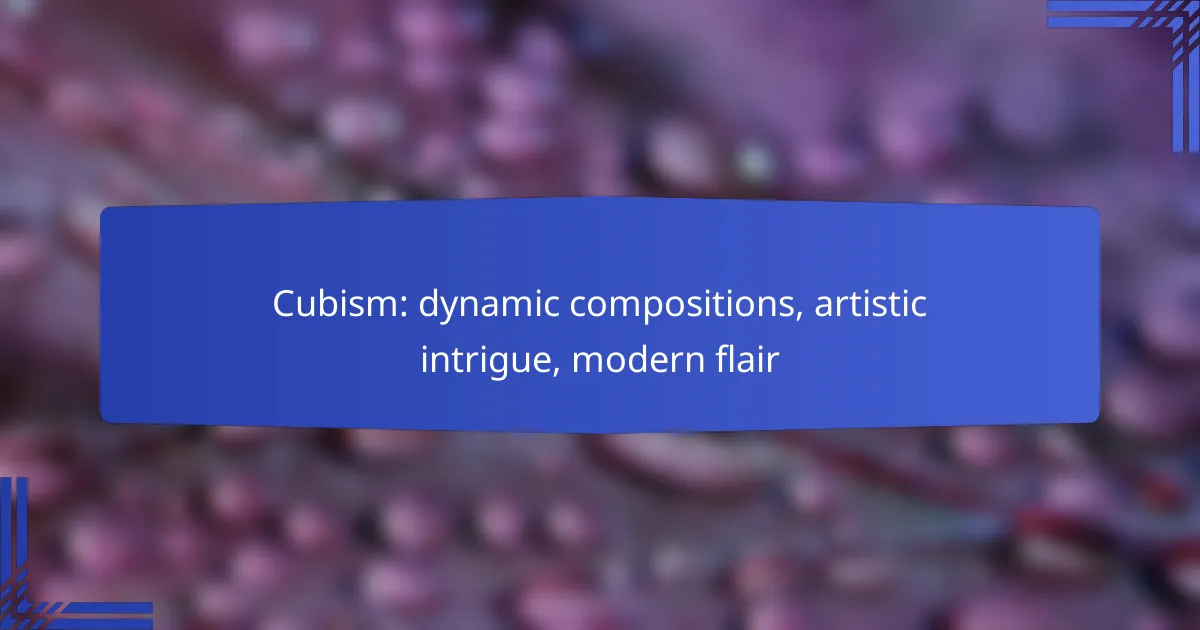Cubism emerged in the early 20th century as a revolutionary art movement that transformed traditional artistic conventions through its innovative use of fragmented perspectives and geometric abstraction. Artists like Pablo Picasso and Georges Braque redefined the representation of reality, creating dynamic compositions that invite viewers to engage with multiple viewpoints simultaneously. This avant-garde approach not only influenced modern art in London but also continues to inspire contemporary creators with its artistic intrigue and modern flair.

How does Cubism influence modern art in London?
Cubism significantly influences modern art in London by challenging traditional artistic conventions and encouraging innovative approaches to composition and form. Artists in the city draw inspiration from Cubism’s fragmented perspectives and geometric abstraction, leading to dynamic and thought-provoking works.
Integration of geometric shapes
Cubism’s hallmark is its integration of geometric shapes, which artists use to deconstruct and reconstruct subjects. This approach allows for a more abstract representation, moving away from realistic depictions. In London, many contemporary artists incorporate these geometric elements into their work, creating visually striking pieces that engage viewers on multiple levels.
For example, a painting might feature a subject represented through overlapping cubes and spheres, inviting the audience to perceive it from various angles. This technique not only enhances visual interest but also encourages a deeper exploration of the subject matter.
Reinterpretation of perspective
Cubism reinterprets perspective by presenting multiple viewpoints simultaneously, which contrasts sharply with traditional linear perspective. This method allows artists to convey the complexity of their subjects, reflecting the multifaceted nature of modern life. In London, this reinterpretation can be seen in various art forms, from painting to sculpture.
Artists often experiment with layering and transparency, creating works that challenge viewers to reconsider how they perceive space and depth. This innovative perspective invites a more interactive experience, as audiences are encouraged to engage with the artwork from different angles.
Impact on contemporary artists
The impact of Cubism on contemporary artists in London is profound, as it has paved the way for various movements, including abstract expressionism and modernism. Many artists today adopt Cubist principles, using them as a foundation to explore new themes and techniques. This influence is evident in galleries and exhibitions across the city.
Emerging artists often blend Cubist elements with other styles, creating unique fusions that reflect their personal narratives and cultural backgrounds. This ongoing evolution of Cubism ensures its relevance in the modern art scene, inspiring a new generation to push the boundaries of artistic expression.

What are the key characteristics of Cubism?
Cubism is characterized by the fragmentation of objects, the representation of multiple viewpoints, and the use of muted colors. This avant-garde movement, which emerged in the early 20th century, revolutionized the way artists depicted reality by breaking down forms and reassembling them in abstract ways.
Fragmentation of objects
Fragmentation in Cubism involves breaking down subjects into geometric shapes and interlocking planes. This technique allows artists to depict various aspects of an object simultaneously, creating a sense of depth and movement. For example, a still life may be represented with overlapping cubes and triangles, challenging traditional perspectives.
When exploring fragmentation, consider how different angles and dimensions can alter perception. Artists like Pablo Picasso and Georges Braque often used this method to emphasize the complexity of their subjects, inviting viewers to engage with the artwork from multiple angles.
Multiple viewpoints
Multiple viewpoints are essential to Cubism, as they depict a single subject from various perspectives within the same composition. This approach reflects the idea that reality is not fixed but rather perceived differently depending on the observer’s position. An example is Picasso’s “Les Demoiselles d’Avignon,” where figures are shown from both frontal and profile views.
To effectively utilize multiple viewpoints, artists should experiment with overlapping forms and angles. This technique can create a dynamic and engaging visual experience, encouraging viewers to explore the artwork more deeply.
Use of muted colors
Cubism often employs a palette of muted colors, such as browns, grays, and greens, which helps to emphasize form over color. This subdued color scheme allows the viewer to focus on the shapes and structures within the artwork rather than being distracted by vibrant hues. The use of muted tones can evoke a sense of seriousness and introspection.
When working with color in Cubism, consider limiting your palette to enhance the overall composition. This approach can create a harmonious balance and draw attention to the fragmented forms, reinforcing the movement’s core characteristics.

Which artists are pivotal to the Cubism movement?
The Cubism movement is primarily defined by the innovative contributions of artists like Pablo Picasso, Georges Braque, and Juan Gris. Their unique approaches to form and perspective reshaped the landscape of modern art, emphasizing dynamic compositions and abstract representation.
Pablo Picasso
Pablo Picasso is often regarded as the father of Cubism, co-developing the style with Georges Braque. His works, such as “Les Demoiselles d’Avignon,” challenge traditional perspectives by depicting subjects from multiple viewpoints simultaneously, creating a fragmented yet cohesive visual experience.
Picasso’s use of geometric shapes and bold colors helped to convey emotion and movement, making his pieces not only visually striking but also rich in meaning. His ability to blend abstraction with recognizable forms set a precedent for future artistic movements.
Georges Braque
Georges Braque played a crucial role alongside Picasso in the formation of Cubism. His works often focused on still life and landscapes, employing a muted color palette that emphasized structure over color. Braque’s approach allowed for a deeper exploration of form and space, as seen in pieces like “Violin and Candlestick.”
By breaking down objects into their essential geometric components, Braque encouraged viewers to engage with the artwork on a more intellectual level. His collaboration with Picasso led to the development of analytical Cubism, which further refined the movement’s principles.
Juan Gris
Juan Gris is recognized for his distinctive contributions to Cubism, particularly through his use of color and composition. Unlike Picasso and Braque, Gris often incorporated a brighter palette and a more decorative style, which can be seen in works like “The Breakfast Table.” His approach added a sense of clarity and order to the chaotic elements of Cubism.
Gris’s emphasis on the interplay of light and shadow, along with his innovative use of collage, helped to advance the movement. His ability to blend Cubist principles with a more approachable aesthetic made his work accessible to a broader audience, ensuring Cubism’s lasting impact on modern art.

How can you identify Cubist artworks?
Cubist artworks can be identified by their distinctive use of geometric shapes, fragmented forms, and multiple perspectives. These characteristics create dynamic compositions that challenge traditional representation in art.
Geometric abstraction
Geometric abstraction is a hallmark of Cubism, where artists reduce subjects to basic geometric shapes like cubes, spheres, and cones. This simplification allows for a unique interpretation of reality, emphasizing structure over detail.
For instance, a still life might be depicted using interlocking triangles and rectangles, creating a sense of depth and complexity. This approach encourages viewers to engage with the artwork on a conceptual level, rather than merely a visual one.
Overlapping planes
Overlapping planes are another key feature of Cubist art, where different facets of an object are shown simultaneously. This technique creates a sense of movement and dynamism, as if the viewer is seeing the subject from multiple angles at once.
In practice, this might involve layering various shapes and colors to form a cohesive image, often resulting in a fragmented appearance. Artists like Pablo Picasso and Georges Braque utilized this method to challenge conventional perspectives and invite deeper contemplation.
Distorted forms
Distorted forms in Cubism serve to emphasize the artist’s interpretation rather than a realistic representation. Objects may appear elongated, skewed, or abstracted, which can evoke emotional responses and provoke thought.
For example, a human figure might be depicted with exaggerated proportions or angular features, highlighting the essence of the subject rather than its physical attributes. This distortion encourages viewers to explore the underlying themes and ideas presented in the artwork.

What are the historical roots of Cubism?
Cubism emerged in the early 20th century as a revolutionary art movement that broke away from traditional perspectives. Its roots can be traced back to influences from African art, the development of modernist ideas, and connections to other movements like Fauvism.
Influence of African art
African art significantly impacted the formation of Cubism, particularly through its use of abstraction and simplified forms. Artists like Pablo Picasso and Georges Braque drew inspiration from African masks and sculptures, which encouraged them to explore new ways of representing reality. This influence led to a departure from realistic depictions, favoring geometric shapes and fragmented perspectives.
Development in early 20th century
The development of Cubism occurred primarily between 1907 and 1914, marking a pivotal shift in artistic expression. Early works, such as Picasso’s “Les Demoiselles d’Avignon,” showcased a radical break from traditional representation and perspective. This period saw artists experimenting with form, color, and composition, leading to the establishment of two main phases: Analytic and Synthetic Cubism.
Connection to Fauvism
Cubism shares a connection with Fauvism through its emphasis on color and emotional expression. While Fauvism focused on bold colors and painterly techniques, Cubism introduced a more structured approach to composition. Both movements challenged conventional aesthetics, but Cubism took it further by deconstructing objects into geometric shapes, allowing for multiple viewpoints within a single artwork.

What are the different phases of Cubism?
Cubism is primarily divided into two main phases: Analytical Cubism and Synthetic Cubism. Analytical Cubism, developed first, focuses on deconstructing objects into geometric shapes, while Synthetic Cubism later emphasizes the construction of new forms through collage and mixed media.
Analytical Cubism
Analytical Cubism emerged in the early 20th century, primarily between 1907 and 1912. This phase is characterized by a monochromatic palette and the fragmentation of subjects into overlapping planes, which allows for multiple perspectives to be viewed simultaneously.
Artists like Pablo Picasso and Georges Braque were pioneers of this style, often depicting still lifes and figures in a way that challenges traditional representation. The goal was to analyze the subject from various angles, creating a more complex understanding of form.
Synthetic Cubism
Synthetic Cubism developed around 1912 and introduced brighter colors and simpler shapes compared to its predecessor. This phase is marked by the incorporation of mixed media, such as collage, where artists would use materials like newspaper clippings and fabric to create compositions.
This approach allowed for greater experimentation and creativity, as artists combined various elements to construct new realities. The use of texture and pattern became more pronounced, making works visually dynamic and engaging.
